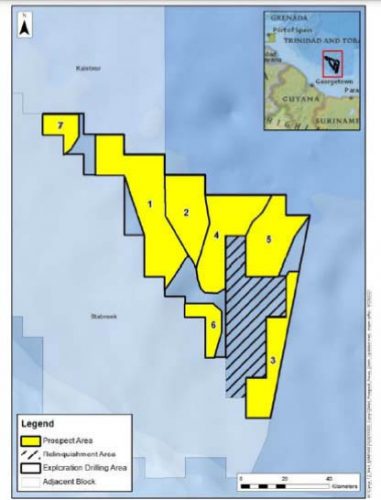The decision by the Environmental Protection Agency (EPA) to waive the Environmental Impact Assessments (EIAs) for two 12-well exploration campaigns in the Kaieteur and Canje Blocks, offshore Guyana, by ExxonMobil, is being objected to by environmentalist Simone Mangal-Joly.
Last week, EPA announced that having reviewed the company’s drilling programme for exploration and its appraisal of 12 wells in the Kaieteur Block, it has concluded that there is no requirement for an EIA. Meanwhile, a similar notice in relation to the Canje Block exploration was published back on February 14, 2022.

“In accordance with Section 11(2) of the Environmental Protection Act, CAP 20:05, Laws of Guyana, the application for the project listed above has been screened by the Agency to assess the potential environmental impacts. It has been determined that the project will not significantly affect the environment or human health. It is, therefore, exempt from the requirement of an Environmental Impact Assessment (EIA),” the notice from the EPA had said in both instances.
It also announced a 30-day period for persons to make objections to the Environmental Assessment Board (EAB).
In a letter, dated March 11, 2022 and seen by Sunday Stabroek, Mangal-Joly wrote to Chairman of the EAB Omkar Lochan, objecting to the decisions on the ground of lack of data.
“…the Agency lacks the relevant empirical data required to conclude that the proposed drilling activities are not likely to significantly impact the natural environment or Guyana’s offshore fish populations and fisheries sector. The Agency must be in possession of adequate information before it can decide that a proposed activity will not significantly adversely affect the environment,” Mangal-Joly said in her letter.
The environmentalist argued that there is no recorded evidence in the already completed EIAs for Exxon’s activities offshore nor in the baseline studies conducted that pinpoints the locations of coral reefs and fish nurseries relative to existing drill sites and/or proposed exploratory drill sites. She added that there is no baseline information in any of the studies, to which Exxon’s applications refer, on fish and mammal life cycle and migratory patterns, and the extent and full economic and socio-economic value of offshore-related fisheries or near-shore fisheries affected by offshore oil and gas logistic activities.
“There are no baseline biological assays of fish, biomarkers of fish population and communities, or any related monitoring and evaluation data for these and other relevant parameters in and around areas where production and exploratory drilling is in progress or has been concluded.
“I trust that you understand that the impacts of Kaieteur and Canje multi-well drilling activities scheduled to run from 2022-2027, cannot be disassociated from the Stabroek-25 well, Stabroek 12-well, Canje 3-well, Liza Phase 1, Liza Phase 2, Payara, and Yellowtail developments or the activities of other oil and gas actors offshore. The EPA Act Section 17 requires a cumulative impact assessment,” she explained.
According to the project description, the drilling of the wells is expected to commence in the 4th quarter of 2022 with conclusion of the proposed drilling campaign expected by the first quarter of 2027.
Based on the water depths in the Kaieteur Block, multiple dynamically-positioned drill ships would be used to drill the wells. The Kaieteur Multi-well Programme aims to gather data on the reservoir characteristics, hydrocarbon presence, pressure, and temperatures. If the presence of hydrocarbons is discovered, wells will be tested to establish the limits of the reservoir.

Additionally, the productivity of wells and the oil or gas properties present will be tested. Once the proposed drilling operations are complete, the exploration well will be permanently plugged and abandoned
Magal-Joly is arguing that adequate data must be available on the specific and relative locations of each activity, sensitive ecological features as well as biophysical parameters such as ocean currents and interactions among all these parameters. She also pointed to an October 22, 2021 letter in which she raised objections to the decision to waive the EIA for the Block’s 12-well exploration campaign when EPA first published it.
“You would also recall that on August 28, 2021, I objected to the EPA’s first notice to waive an EIA for the Canje-12 well drilling campaign on grounds that the Agency had violated Section 36 of the Environmental Protection Act by failing to provide reasons. You acknowledged this violation in your letter to me of October 26, 2021,” Mangal-Joly reminded.
In that letter, seen by Sunday Stabroek, Lochan had informed Mangal-Joly that the applications by Exxon did not satisfy the requirements in the Environmental Protection Act and as such they were advised to “withdraw their applications and resubmit new applications in keeping with the Act and Regulations.”
The new applications were resubmitted and Mangal-Joly is now objecting to the waiving of the EIA.
Screening report
Mangal-Joly also brought it to the EAB’s attention the EPA’s failure to publish its screening report despite being required to do so.
“…as of today March 11, 2021, I have not been able to find the screening report for the Kaieteur drilling campaign under the Screening Reports link on the EPA’s website or under the EEPGL documents link. You are aware that these reports ought to be available for the full statutory 30-day period in which the public may examine the EPA’s decision and register any objection.
“I would be grateful for a copy of the Kaieteur-12 well Screening Report as well as the screening methodology that the EPA has applied, which as you know, ought to be transparently available so that the public may exercise its right to evaluate the merits of the Agency’s decision in accordance with the intention of the EPA Act,” she said in her letter.
EPA had initially published the screening report last week but has removed it without reason. Sunday Stabroek was able to download the report on Tuesday. In it, the EPA concluded “Project impacts have been deemed negligible to low, short-term and localized. An Environmental Impact Assessment (EIA) is not required based on the screening. However, an Environmental Management Plan (EMP) is required to outline the measures to be implemented to mitigate the impacts associated with the Project.”
The document also explained that the EPA’s screening concludes that the Project will not have a significant environmental impact, providing all proposed embedded control mechanisms and practices are implemented.






